| Musiquarium | Sep 26 2022 |

Rarely has adult contemporary music inspired thoughts quite this adult.
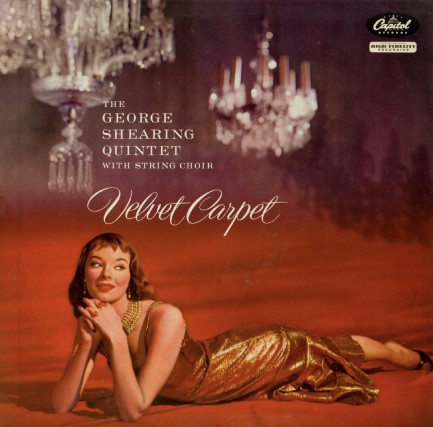
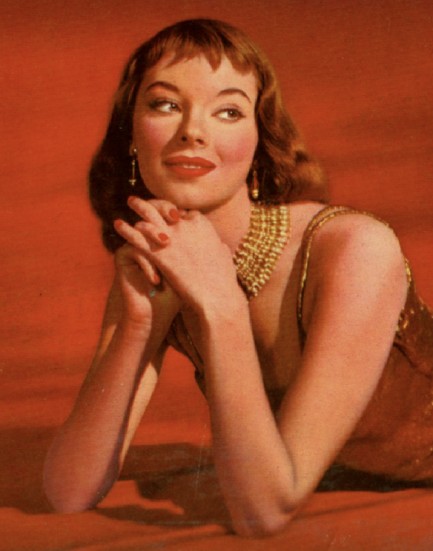
The lovely sleeve you see above for the 1956 George Shearing Quintet album Velvet Carpet features as its cover model the always alluring Vikki Dougan, nicely posed in a gold gown that covers far more of her body than fans could have reasonably expected based on her many racy promo images. The photos of her below actually holding the album while wearing see-through lingerie are more in keeping with her usual modus operandi. Shearing, who was born blind yet became a virtuoso pianist, was a very popular performer beginning in 1950 and continuing though the 1980s. That's a nice run for a musician. We went online and checked out the tunes on this platter. They're pure easy listening, which, contrary to its name, made us uneasy as hell. But as our ears rebelled, Dougan was on hand to soothe our eyes, so it worked out fine.
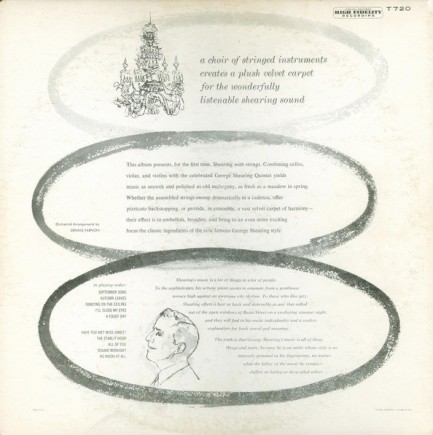
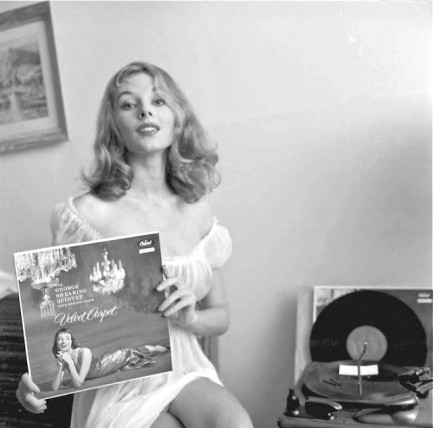
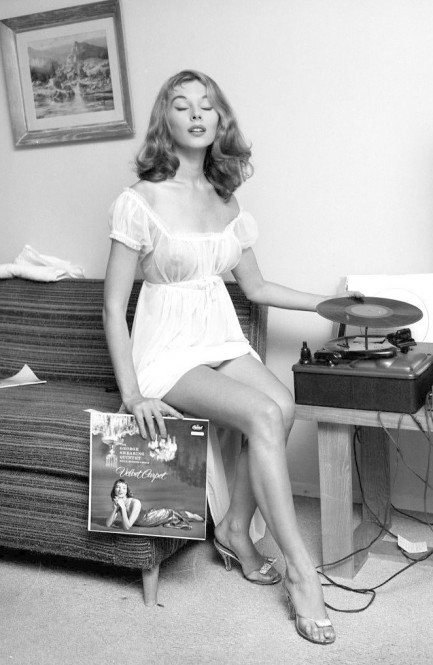
| Musiquarium | May 9 2022 |

You should have started long before now to look good for June.
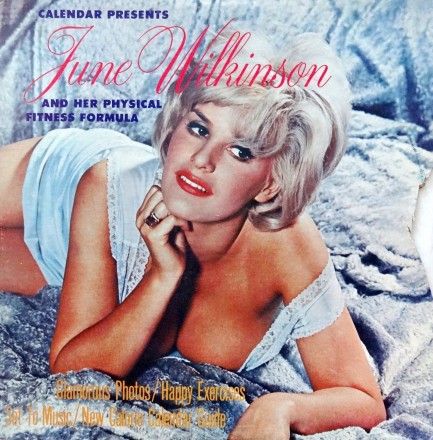
May is when the typical person really starts thinking about his or her beach body. Sadly, they should have started thinking about it in November or December to have a shot at a skinny summer, but who can pass up all that holiday food? Well, British pin-up June Wilkinson wanted to help. Fitness is a time honored niche for celebrities who can't quite sustain careers in more glamorous areas. Sometimes those who go into the field were never true stars. Other times they were top of the heap but fell off, like Jane Fonda when she became a fitness queen during the 1980s, or Miss Thighmaster of 1991, Suzanne Somers.
Wilkinson was in the never category. She wasn't a big star on screen or television, but was popular as a model—and people always want to know how models stay fit. Calendar Records was happy oblige the public by releasing a Wilkinson exercise record in 1962. Titled June Wilkinson and Her Physical Fitness Formula, the platter featured instrumental tunes along with exercise lessons narrated by Wilkinson, among them those classic old school calisthenics like swing kicks and leg raises. There's also a fitness guide, a calorie calendar, a chart of desirable weights for various heights, a sample menu, and of course, photos of Wilkinson demonstrating the exercises.
We have no sales figures for the record, but if it had been a runaway success she'd have made another—which she didn't. But it probably wasn't June's fault. Calendar Records was a fledgling imprint that went on to release a few obscure singles and a political spoken word record by Barry Goldwater. Need we say more? We have a bit more Wilkinson in the website. We recommend checking out her famous tongue here (maybe some tongue exercises would have helped the record's sales), and the famous rest of her here.
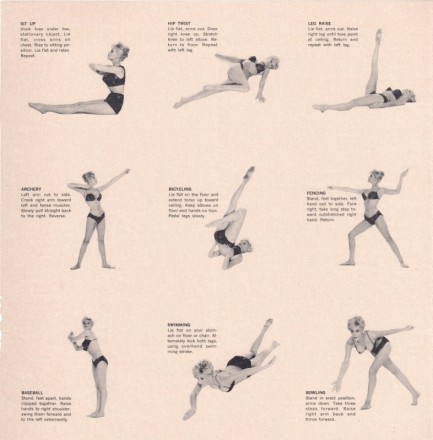
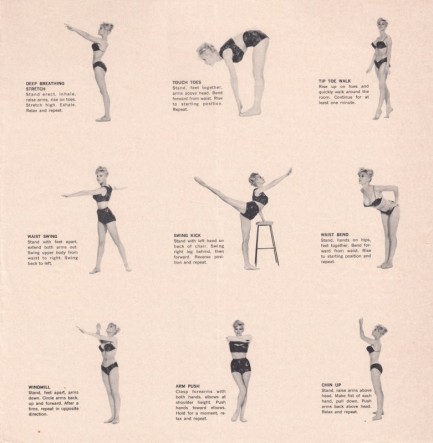
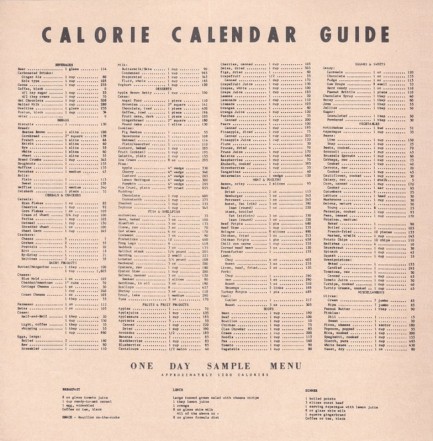
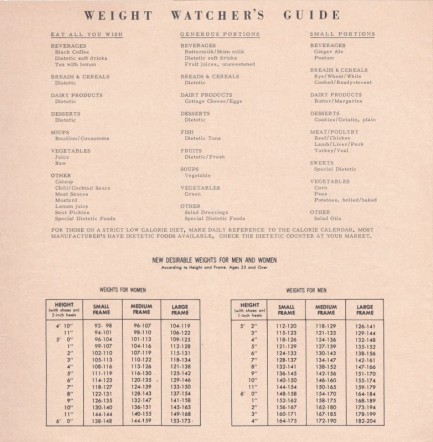
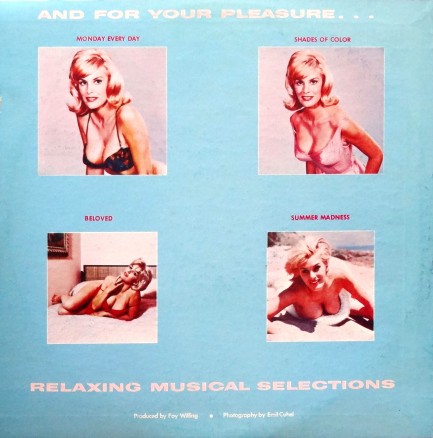
| Musiquarium | Jul 13 2021 |

I'm supposed to be working plainclothed but what's a queen to do?
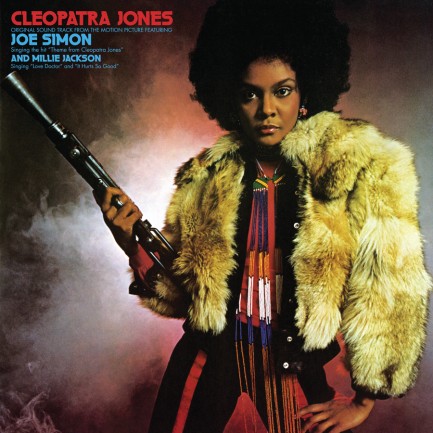
The blaxploitation film Cleopatra Jones premiered today in 1973, so we thought it was an appropriate moment to post this sleeve for the soundtrack, a pretty good record, like blaxploitation soundtracks tended to be. It's a re-issue, which is why it looks so pristine. The artists include Joe Simon & The Mainstreeters on the title tune, plus contributions from Millie Jackson, Carl Brandt, and J.J. Johnson. But our interest in this is the image of star Tamara Dobson, who plays the titular badass government agent cum fashion plate. We cropped and de-texted the cover and the result is the poster-like image you see below. Fun movie too.
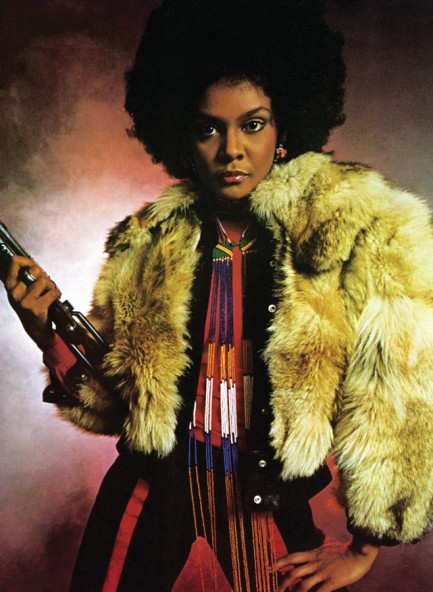
| Musiquarium | Jun 17 2021 |

Monroe doesn't even have to be real to steal the show.
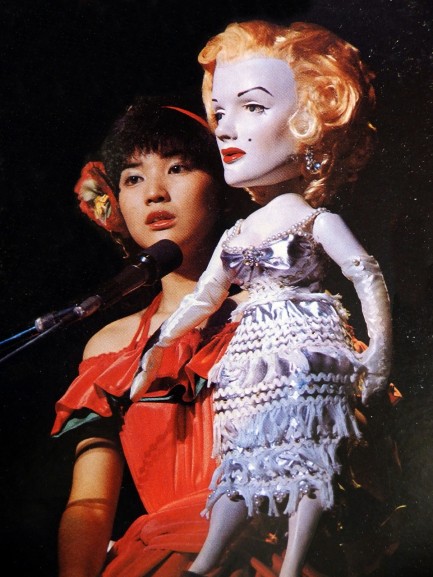
Bet you've never seen anything quite like this before. And depending on how you feel about dolls maybe you don't want to see anything like it again. The photo shows Japanese singer Junko Sakurada performing with a terrifying—er, we mean fascinating—doll of film immortal Marilyn Monroe. This is not quite as leftfield a pairing as it looks. Sakurada covered the Monroe song “I Wanna Be Loved by You” on her 1976 live album Nee ki ga tsuite yo, aka Hey! Be Aware, so she's possibly performing that tune with the help of some terrifying—er, we mean appealing—visual accompaniment. Try not to imagine this nightmare version of Monroe being somewhere inside your house when you go to sleep tonight.
| Femmes Fatales | Musiquarium | Mar 2 2021 |

The performance was good, but the encore was unforgettable.

We asked you to stay tuned, and quicker than you can say ring-a-ding-ding above is Setsuko Ogawa as promised. Her guitar isn't just for decoration. In addition to her many film credits she released a 1973 single and later sang the theme song of the Nikkatsu Studios roman porno flick Enka Jôshikô: Kizudarake no Kaben—translation: “petals full of scars”—in which she headlined.
We've seen Ogawa described as the first roman porno star, and that could be true. Her debut film was 1971's Irogoyomi ōoku hiwa, aka Castle Orgies, and it was Nikkatsu's first official offering from its radical new genre, or possibly the second, depending on which source you believe. She starred in another Nikkatsu movie that year, so she was certainly among the genre's first recognizable faces.
The above image was pasted together from two larger shots and put online several years ago. We found full-frame versions of those separate shots, but not at a useful resolution, so two cropped shots stuck together like Siamese twins is what you get. However the resolution on that image is good, so we put it under the digital knife and split it during a dicey operation that took all of five seconds, with the results below. We'll have more from Ogawa at some point.




| Femmes Fatales | Musiquarium | Feb 27 2021 |

Hmm... it's always a tough decision. Which of my many talents should I flaunt today?
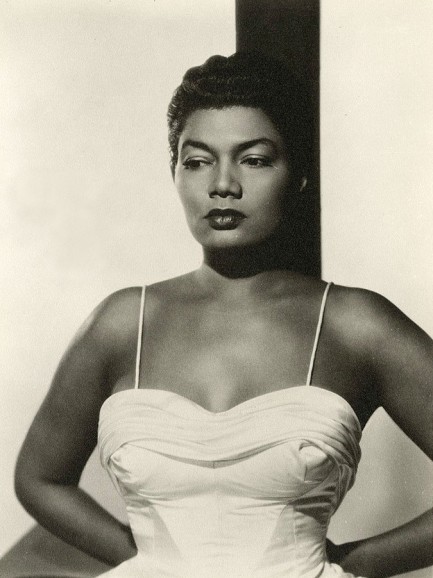
Above is a photo of vaudevillian, stage actress, movie star, television host, writer, and internationally renowned singer Pearl Bailey. She excelled in all the various areas of her artistic pursuits, but began her career as a nightclub performer, for years touring around the U.S. before her rise to household fame began by appearing in movies, firstly 1947's Variety Girl. The next year she split a platter with Buddy Clark, and went on to release more than two dozen albums. The regal image above is undated, but were we to guess, we'd say it's probably from around the time she appeared in the hit film Carmen Jones in 1954.
| Musiquarium | Feb 5 2021 |

Turns out the French were the first to land on another planet.
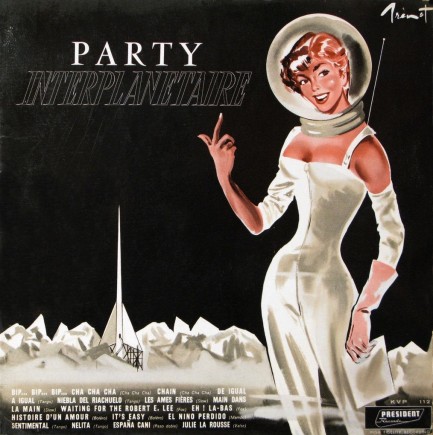
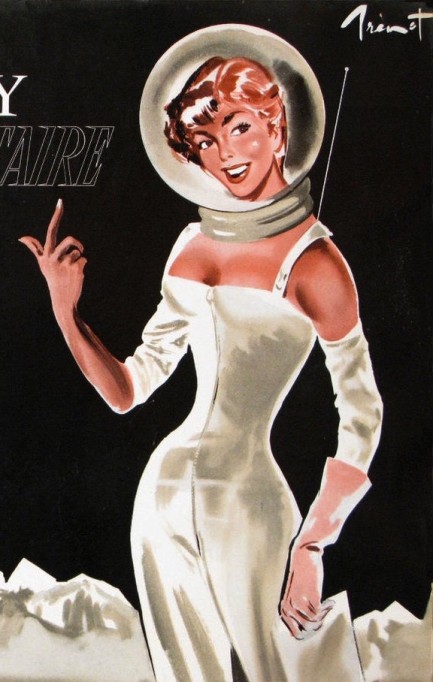
It's been a while since we've looked at the output of genius illustrator Raymond Brenot, so today we have a record cover he painted in 1957 for a compilation disc called Party Interplanetaire. This is tasty work in the classic pin-up mode that made him deservedly famous under both his own name and his occasional pseudonym Carols. So who's on this vinyl? That would be Jo Courtin, Otto Rubini, Ray Massey, Conrad Janis, and Los Cangaceiros. Household names, right? Well, we never heard of them. If you have, good on you. If you're unfamiliar and want to hear a few examples, check here and here. But does the music really matter? If you have this just lose the platter and frame the sleeve.
| Musiquarium | Dec 30 2020 |

Get ready for two 45 shots right between the ears.
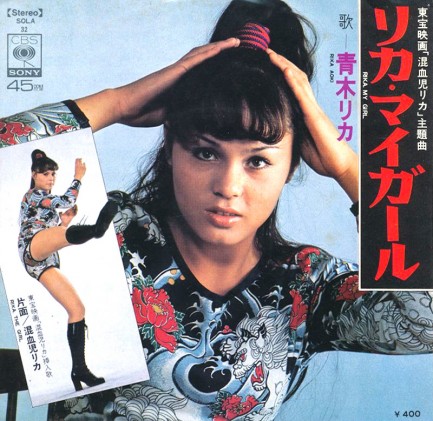
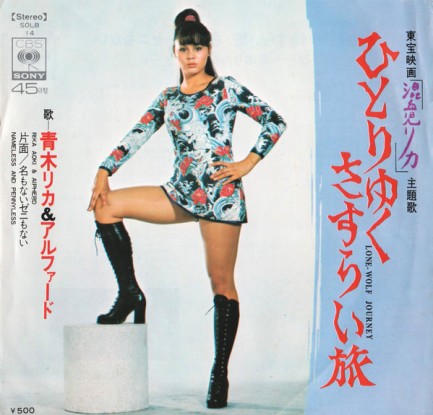
We ran across these 45 record sleeves of kick-happy Japanese action star Rika Aoki to add to the collection of images we've already shared. The first record has a tune called, “Rika the Girl,” on the A, and “Rika My Girl,” on the flipside. The second record, on which she collaborated with an artist known as Alphard, has, “A Wandering Trip Alone,” on the A (by the way, a very poetic title, we think), and, “No Nameless Zeni,” on the flip. Forget the music—just dig her danger shirtdress. But if you must hear it, try here and here. No guarantees. People who normally listen to very good music are at high risk of serious side effects from listening to J-pop. These may include nausea, dizziness, vomiting, explosive diarrhea, and suicidal thoughts. In rare cases listening to J-pop can induce brain bleeds and pulmonary failure. The worst side effect could be realizing you like J-pop. Consult your physician about whether you are in robust enough condition to consume J-pop.
| Musiquarium | May 29 2020 |

If you're happy and you know it drop your shirt.
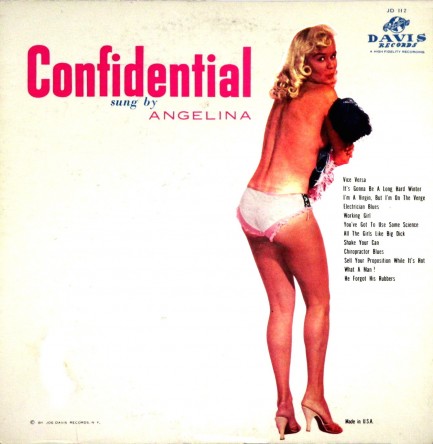
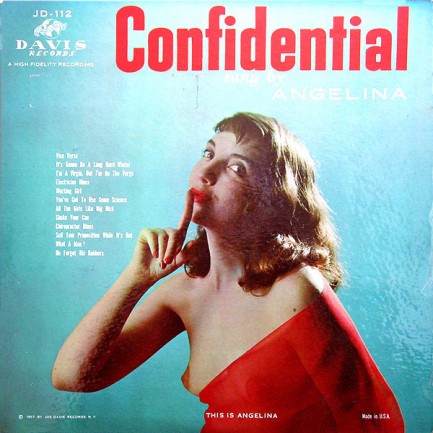
Here's a historical curiosity. Above are two pressings of an album from Angelina, aka Angelina the Singing Model, released in 1957. Sharp-eyed readers may notice that the sleeves use the name and title font of the iconic mid-century tabloid Confidential. The platters were put out by Davis Records, owned by recording entrepreneur Joe Davis, and try as we might, we uncovered no connection between him and Confidential publisher Robert Harrison. Anything is possible, though. They were both New York based, were both publishers—though of different media—so we bet they knew each other. Did Harrison have any idea his font had been borrowed? There's no way we can know.
During the summer of 1957, when this album was recorded and hit stores, Harrison was deeply involved in the libel case that would lead to him selling Confidential. The trial was in L.A., and he stayed in NYC, refusing to appear in court out west, but even so the proceedings kept him plenty busy. Too busy to notice that a novelty album infringed on his logo? We doubt it. Someone, somewhere in Manhattan, would have said, “Hey, Robert, have you seen this new record that uses the font from your magazine?” For that reason we can't help feeling there's some link between Davis and Harrison that led to the look of these LPs, but for now that will have to remain a mystery.
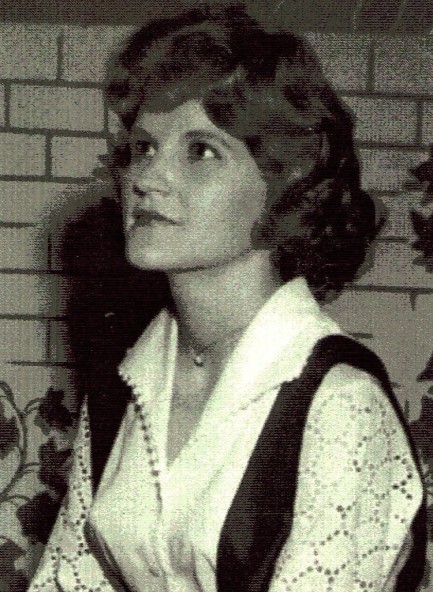
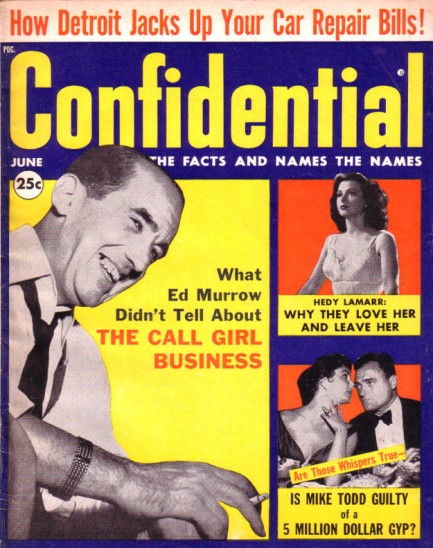 Moving on to the singer, Angelina was actually New York City-based Joyce Heath, who later founded Joyce Heath and the Privateers. These platters, unlikely as the possibility seems, may have actually helped launch her career. As we said, they came in 1957, and Heath's first recordings under her own name were in 1959. Maybe she kept her semi-topless starring role on the cover of Confidential quiet, but we think it more likely she embraced it. While she does show her breast on the second cover, one little boob, after all, was not that big of a deal post-Monroe and Mansfield.
Moving on to the singer, Angelina was actually New York City-based Joyce Heath, who later founded Joyce Heath and the Privateers. These platters, unlikely as the possibility seems, may have actually helped launch her career. As we said, they came in 1957, and Heath's first recordings under her own name were in 1959. Maybe she kept her semi-topless starring role on the cover of Confidential quiet, but we think it more likely she embraced it. While she does show her breast on the second cover, one little boob, after all, was not that big of a deal post-Monroe and Mansfield.The album had either a repressing or was initially released with two sleeves. Since there are two levels of explicitness, we suspect the latter. Davis probably wanted a suggestive cover, and one that was even more risqué. On the other hand, the change in Heath's hair color suggests the former possibility—two pressings at different times with a change of hairstyle between. Both albums have 1957 copyrights, though, which means little time would have elapsed. Alternatively it could be that Heath wasn't the model for both covers. But we think she was. The second sleeve says in white lettering across her red shirt, “This is Angelina.” So there you go. And the first model, if you look past the hair color, resembles Heath strongly. At least to us.
And now we get to the music. You want to know whether it's any good, right? Well, it's a joke record, with double entendre songs like, “All the Girls Like Big Dick,” “Shake Your Can,” and “He Forgot His Rubbers.” We gave it a listen and all the tunes are cabaret style, pairing piano and vocal with no other accompaniment. Twelve tunes of that ilk would begin to sound similar anyway, but in this case, they really are all the same song. Same key, same tempo, same mood, etc. We have it on good authority Heath recorded this in one afternoon and what we heard sure lends credence to that assertion. Still, limited as the music may be, it's pretty fun. If you want to know more about Joyce Heath, check the blog whitedoowopcollector at this link.
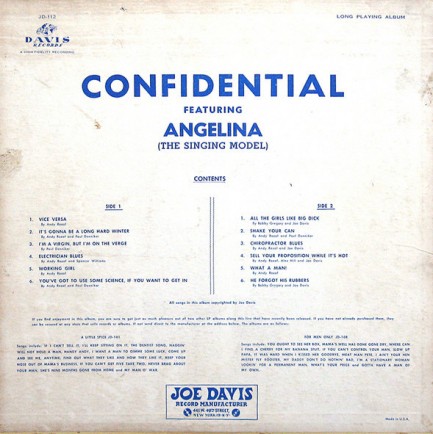
| Femmes Fatales | Musiquarium | Feb 28 2020 |

Sugar and spice and everything nice.
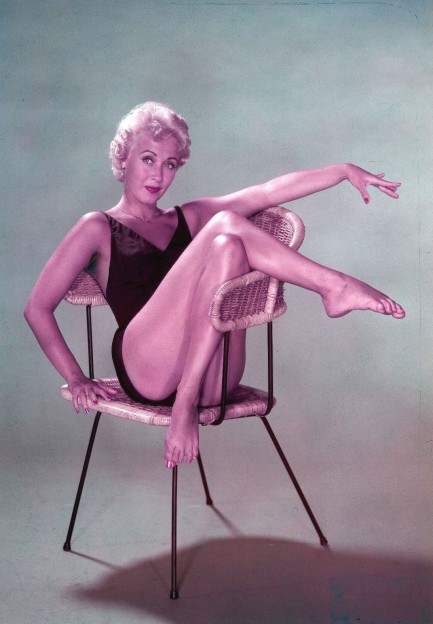
Above is shot of cinematic girl-next-door Jane Powell, who rose to fame in Hollywood musicals such as Holiday in Mexico, Seven Brides for Seven Brothers, and Royal Wedding. While Powell is fondly remembered for those and similar roles, she found it ridiculous that she played teenagers into her mid-twenties even though she had children of her own by that point. Under the studio system she had little choice, but later she did manage to expand her repertoire, co-starring in the Hedy Lamarr melodrama The Female Animal. Afterward she turned her attentions mainly to television, with guest slots on everything from Goodyear Theatre to Fantasy Island. She also had stage and singing careers, and scored a top 20 hit with 1956's “True Love.” The photo you see here was made to promote her 1957 musical The Girl Most Likely, and a shot from the same session appeared on the cover of the soundtrack album, which you see below. We don't generally do musicals here, but we will certainly check out her dramatic turn in The Female Animal. Meanwhile you may want to check out this rare photo we shared a couple of years ago.
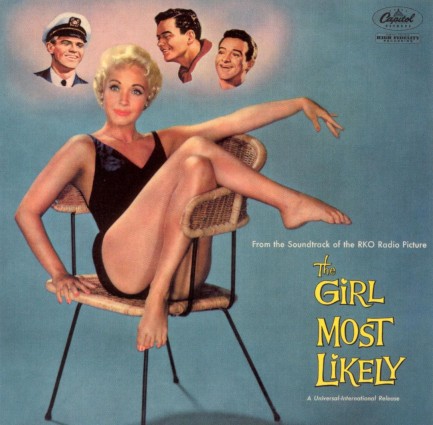
 |
 |




































































